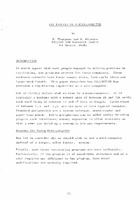| dc.contributor.author | Thompson, Martin | |
| dc.contributor.author | Wijmans, Willem | |
| dc.date.accessioned | 2018-10-11T14:08:16Z | |
| dc.date.available | 2018-10-11T14:08:16Z | |
| dc.date.issued | 1972/05 | |
| dc.identifier | 104 | |
| dc.identifier.govdoc | CP-6 | |
| dc.identifier.uri | http://hdl.handle.net/20.500.12489/437 | |
| dc.description.abstract | It would appear that most people engaged in solving problems in ray- tracing, use programs written for large computers. These machines commonly have large memory si~es, fast cycle times and large word length . This paper describes how SACLANT CEN has provided a ray- tracing capability on a mini-computer . Let us firstly define what we mean by a mini- computer. It is typically a machine with a memory si~e of between lK and 32K words , each word being of between 12 and 18 bits in length. Cycle times of between 1 u s and 2 u s are the norm of this type of computer. Standard peripherals are a system teletype, photo-reader and paper tape punch . Extra peripherals can be added easily by using plug- in card interfaces; memory expansion is often available so that a user can build up a system to his own requirements | |
| dc.format | 9 p. : ill. ; digital, PDF file | |
| dc.language | English | |
| dc.publisher | NATO. SACLANTCEN | |
| dc.source | In: SACLANTCEN Conference Proceedings 6 (1972), pp. 75-84 | |
| dc.subject | Ray tracing | |
| dc.subject | Acoustic propagation | |
| dc.title | Ray tracing on a mini-computer | |
| dc.type | Papers and Articles | |
| dc.type | Conference Proceedings (CP) | |
